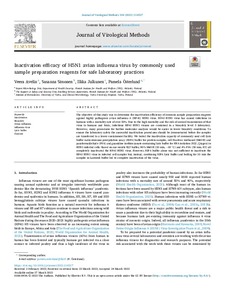Inactivation efficacy of H5N1 avian influenza virus by commonly used sample preparation reagents for safe laboratory practices
Avelin Veera; Sissonen Susanna; Julkunen Ilkka; Österlund Pamela
https://urn.fi/URN:NBN:fi-fe2022081154402
Tiivistelmä
The objective of this study was to determine the inactivation efficiency of common sample preparation reagents against highly pathogenic avian influenza A (HPAI) H5N1 virus. HPAI H5N1 virus has caused infections in humans with a mortality rate of over 50%. Due to the high mortality and the risk of aerosol transmission of that virus to humans and birds, infectious HPAI H5N1 viruses are contained in a biosafety level 3 laboratory. However, many procedures for further molecular analyses would be easier in lower biosafety conditions. To ensure the laboratory safety the successful inactivation procedures should be demonstrated before the samples are transferred to a lower containment facility. We tested the inactivation capacity of commonly used cell lysis buffer radio-immuno precipitation assay (RIPA) buffer for protein samples, cell fixatives methanol (MeOH) and paraformaldehyde (PFA) and guanidine isothiocyanate-containing lysis buffer for RNA isolation (RLT, Qiagen) in H5N1-infected cells. Based on our results RLT buffer, 90% MeOH (20 min, −20 °C) and 4% PFA (30 min, RT) all completely inactivated the HPAI H5N1 virus. However, RIPA buffer alone was not sufficient to inactivate the HPAI H5N1 virus in infected cell samples but, instead, combining RIPA lysis buffer and boiling for 10 min the samples in Laemmli buffer led to complete inactivation of the virus.
Kokoelmat
- Rinnakkaistallenteet [27094]
